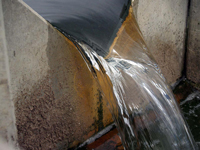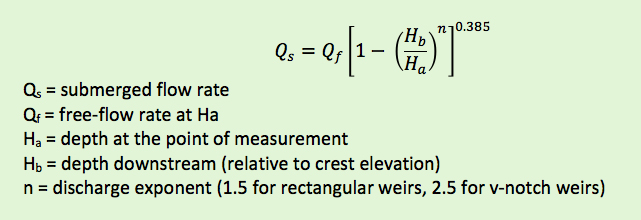Submerged Flow
 For a thin-plate weir to accurately measure flow, the nappe (body of water flowing over the crest) must freely spill into the downstream channel.
For a thin-plate weir to accurately measure flow, the nappe (body of water flowing over the crest) must freely spill into the downstream channel.
As the level in the downstream channel rises, the nappe eventually is no longer sufficiently aerated and collapses. The collapse of the nappe and the rise of the downstream water level create a resistance to free-flow over the weir – resulting in an overstatement of the actual discharge.
It is important to remember that although a weir may have originally designed for free-flow at an installation, changes in the downstream hydraulics can submerged it.
Typically, these changes are to do with:
- Downstream vegetation
- Sediment deposit
- Added hydraulic structures
- Reconfiguration of the downstream channel
Do not assume that a once free-flowing weir will always be a free-flowing weir.
Submerged Flow Equation
To correct for submerged flow, Villemonte provides the following equation:

Secondary Point of Measurement (Hb)
Villemonte recommended that Hb be measured just beyond the turbulence caused by the nappe entering the downstream water's surface, generally 6 to 10-feet [1.83 – 3.05 m] downstream of the weir.
Submerged flow corrections for thin-plate weirs should only be viewed as only a temporary measure to provide an estimate of flow. In the long run, steps should be taken to correct the submergence condition.
These can include:
- Cleaning of weeds, sediment, and debris form the downstream channel
- Raising the weir crest
- Installing a different primary device
Image: Def/Mo via Flickr


